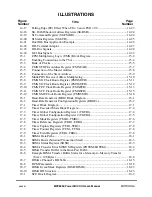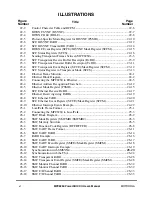
MOTOROLA
Illustrations
xxxix
ILLUSTRATIONS
Figure
Number
Title
Page
Number
19-2
GSMR_HÑGeneral SCC Mode Register (High Order) ......................................... 19-3
19-3
GSMR_LÑGeneral SCC Mode Register (Low Order) .......................................... 19-6
19-4
Data Synchronization Register (DSR)..................................................................... 19-9
19-5
Transmit-on-Demand Register (TODR).................................................................. 19-9
19-6
SCC Buffer Descriptors (BDs) .............................................................................. 19-11
19-7
SCC BD and Buffer Memory Structure................................................................. 19-12
19-8
Function Code Registers (RFCR and TFCR) ........................................................ 19-15
19-9
Output Delay from RTS Asserted for Synchronous Protocols .............................. 19-18
19-10
Output Delay from CTS Asserted for Synchronous Protocols .............................. 19-19
19-11
CTS Lost in Synchronous Protocols...................................................................... 19-20
19-12
Using CD to Control Synchronous Protocol Reception ........................................ 19-21
19-13
DPLL Receiver Block Diagram............................................................................. 19-22
19-14
DPLL Transmitter Block Diagram ........................................................................ 19-23
19-15
DPLL Encoding Examples .................................................................................... 19-25
20-1
UART Character Format ......................................................................................... 20-1
20-2
Two UART Multidrop Configurations .................................................................... 20-8
20-3
Control Character Table .......................................................................................... 20-9
20-4
Transmit Out-of-Sequence Register (TOSEQ)...................................................... 20-10
20-5
Asynchronous UART Transmitter......................................................................... 20-11
20-6
Protocol-Specific Mode Register for UART (PSMR)........................................... 20-14
20-7
SCC UART Receiving using RxBDs .................................................................... 20-16
20-8
SCC UART Receive Buffer Descriptor (RxBD)................................................... 20-17
20-9
SCC UART Transmit Buffer Descriptor (TxBD) ................................................. 20-18
20-10
SCC UART Interrupt Event Example ................................................................... 20-20
20-11
SCC UART Event Register (SCCE) and Mask Register (SCCM)........................ 20-20
20-12
SCC Status Register for UART Mode (SCCS) ..................................................... 20-21
21-1
HDLC Framing Structure ........................................................................................ 21-2
21-2
HDLC Address Recognition.................................................................................... 21-5
21-3
HDLC Mode Register (PSMR) ............................................................................... 21-7
21-4
SCC HDLC Receive Buffer Descriptor (RxBD)..................................................... 21-8
21-5
SCC HDLC Receiving Using RxBDs ................................................................... 21-10
21-6
SCC HDLC Transmit Buffer Descriptor (TxBD) ................................................. 21-11
21-7
HDLC Event Register (SCCE)/HDLC Mask Register (SCCM) ........................... 21-12
21-8
SCC HDLC Interrupt Event Example ................................................................... 21-13
21-9
SCC HDLC Status Register (SCCS) ..................................................................... 21-14
21-10
Typical HDLC Bus Multimaster Configuration .................................................... 21-18
21-11
Typical HDLC Bus Single-Master Configuration ................................................. 21-19
21-12
Detecting an HDLC Bus Collision ........................................................................ 21-20
21-13
Nonsymmetrical Tx Clock Duty Cycle for Increased Performance ...................... 21-21
21-14
HDLC Bus Transmission Line Configuration ....................................................... 21-21
21-15
Delayed RTS Mode ............................................................................................... 21-22
21-16
HDLC Bus TDM Transmission Line Configuration ............................................. 21-22
22-1
Classes of BISYNC Frames..................................................................................... 22-1
Summary of Contents for MPC8260 PowerQUICC II
Page 1: ...MPC8260UM D 4 1999 Rev 0 MPC8260 PowerQUICC II UserÕs Manual ª ª ...
Page 66: ...lxvi MPC8260 PowerQUICC II UserÕs Manual MOTOROLA ...
Page 88: ...1 18 MPC8260 PowerQUICC II UserÕs Manual MOTOROLA Part I Overview ...
Page 120: ...2 32 MPC8260 PowerQUICC II UserÕs Manual MOTOROLA Part I Overview ...
Page 138: ...Part II iv MPC8260 PowerQUICC II UserÕs Manual MOTOROLA Part II Configuration and Reset ...
Page 184: ...4 46 MPC8260 PowerQUICC II UserÕs Manual MOTOROLA Part II ConÞguration and Reset ...
Page 202: ...Part III vi MPC8260 PowerQUICC II UserÕs Manual MOTOROLA Part III The Hardware Interface ...
Page 266: ...8 34 MPC8260 PowerQUICC II UserÕs Manual MOTOROLA Part III The Hardware Interface ...
Page 382: ...10 106 MPC8260 PowerQUICC II UserÕs Manual MOTOROLA Part III The Hardware Interface ...
Page 392: ...11 10 MPC8260 PowerQUICC II UserÕs Manual MOTOROLA Part III The Hardware Interface ...
Page 430: ...Part IV viii MOTOROLA Part IV Communications Processor Module ...
Page 490: ...14 36 MPC8260 PowerQUICC II UserÕs Manual MOTOROLA Part IV Communications Processor Module ...
Page 524: ...17 10 MPC8260 PowerQUICC II UserÕs Manual MOTOROLA Part IV Communications Processor Module ...
Page 556: ...18 32 MPC8260 PowerQUICC II UserÕs Manual MOTOROLA Part IV Communications Processor Module ...
Page 584: ...19 28 MPC8260 PowerQUICC II UserÕs Manual MOTOROLA Part IV Communications Processor Module ...
Page 632: ...21 24 MPC8260 PowerQUICC II UserÕs Manual MOTOROLA Part IV Communications Processor Module ...
Page 652: ...22 20 MPC8260 PowerQUICC II UserÕs Manual MOTOROLA Part IV Communications Processor Module ...
Page 668: ...23 16 MPC8260 PowerQUICC II UserÕs Manual MOTOROLA Part IV Communications Processor Module ...
Page 758: ...27 28 MPC8260 PowerQUICC II UserÕs Manual MOTOROLA Part IV Communications Processor Module ...
Page 780: ...28 22 MPC8260 PowerQUICC II UserÕs Manual MOTOROLA Part IV Communications Processor Module ...
Page 874: ...29 94 MPC8260 PowerQUICC II UserÕs Manual MOTOROLA Part IV Communications Processor Module ...
Page 920: ...31 18 MPC8260 PowerQUICC II UserÕs Manual MOTOROLA Part IV Communications Processor Module ...
Page 980: ...A 4 MPC8260 PowerQUICC II UserÕs Manual MOTOROLA Appendixes ...
Page 1002: ...Index 22 MPC8260 PowerQUICC II UserÕs Manual MOTOROLA INDEX ...
Page 1006: ......















































